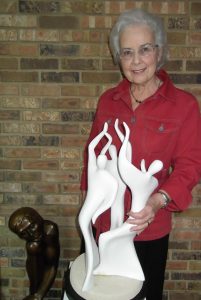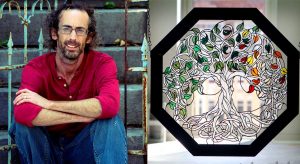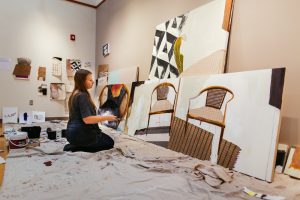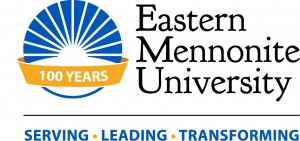In selecting artists for Eastern Mennonite University’s Centennial art installation, curator Ashley Sauder Miller ’03 and the Centennial Visual and Performing Arts Subcommittee sought a range of media, styles and approaches.
Each selected artist will create, over the coming months, 100 new 10-inch x 10-inch new works relating to the Centennial theme of “Eastern Mennonite University 1917-2017: Serving, Leading, Transforming,” the history of Eastern Mennonite University (EMU)/Eastern Mennonite School (EMS), or a depiction of EMU’s vision for the future.
“I’m really pleased with these artists, which include two stylistically different acrylic painters, a mixed-media artist, a stained glass artist and a photographer,” Miller said.
The following selected artists, who join Miller in the undertaking, are already hard at work on their projects:
- Barbara Gautcher, art teacher for 32 years at EMS and EMU.
- Rachel Herr ‘04, Harrisonburg, Va.;
- Zachary Nafziger ‘01, Weyers Cave, Va.;
- Melinda Steffy ‘03, Philadelphia, Pa.
The committee also invited Esther Augsburger ‘72, of Harrisonburg, Va., to participate in the project.
“Esther Augsburger’s participation in developing the art program at Eastern Mennonite School and Eastern Mennonite University continues to be an inspiration to our academic community,” said Louise Otto Hostetter ’79, chair of the Centennial committee. “She has a lifelong commitment of honoring God through her gift of artistry. Esther also played a significant role of supporting art on the global level by organizing Christian artists’ conferences in Asia, Indonesia and Eastern Europe.’
The “10x10x100 Project” culminates in an exhibition in the Margaret Martin Gehman Gallery of University Commons during the Homecoming and Family Weekend, Oct. 13-15, 2017.
Esther Augsburger: Honored artist

Esther Augsburger’s Love Essence, a sculpture depicting the reverential act of footwashing, graces the hillside beside the seminary building. She and her husband, President Emeritus Myron Augsburger (1965-1980), played a pivotal role in the acceptance and eventual flourishing of the arts at EMU. During Myron Augsburger’s tenure, the campus experienced the first instrumental music, drama courses, faculty-mentored theater productions and a new art major.
Esther Augsburger was, fittingly, the program’s first graduate in 1971, though she took all of her art courses at Madison College (now James Madison University). “At the time, only art for elementary school teachers was offered at EMC,” she said.
Augsburger founded the arts program at the high school that same year and taught for the next nine years, while earning a master’s in sculpture from JMU in 1979.
She holds three honorary doctorates, has organized art conferences and displayed her artwork in nine countries.
“I am so honored to participate in this exhibition for the Centennial of the university where I got my start in art,” she said. “Having been the first student to graduate in the major, I feel especially honored.”
Barbara Gautcher

Gautcher, an art teacher, has a long association with both the high school and the university. “I have spent 32 years teaching art to high school students at Eastern Mennonite School, many of whom went on to EMU,” she says, adding that 32 years is “nearly one-third of the Centennial.”
Her project title, “Through the Window,” references the many windows at both schools:
What does one see when looking out a window? For 100 years students, teachers, professors, and future doctors, missionaries, pastors, scientists, businessmen, artists, musicians, etc. have looked out the windows of EMU and EMS while studying, writing, praying and daydreaming. Windows give us a view into the landscape, a vicarious peek at people passing by, and a vision into the future. I am using my sketches and photos of the views outside the windows of EMU and EMS to explore abstract acrylic paintings.
Rachel Herr

Rachel Herr ’04 has created a project that explores “the way women’s roles have changed and continue to change, in the Mennonite church.” She plans to photograph a female friend who embodies “today’s deeply Mennonite, modern woman,” and then grid the black and white portrait onto 100 small squares.
Herr, who majored in art and minored in business, is also a culinary artist. She works as a pastry chef and chocolatier.
A fond memory of her time at EMU was the cross cultural semester in South Africa. “I think of that semester often, enjoy keeping up with others who were on the trip and still wrestle with issues we studied and witnessed firsthand there such as choice and inequality.
Zachary Nafziger
Zachary Nafziger ’01 is a full-time stained glass artist and owner of ZN Stained Glass. His working studios are located in Spitzer Art Center in Harrisonburg.

“I’m excited to be an artist in the Centennial project, not only for the scale of the project, approximately 70 square feet per artist, but for the caliber of participating artists as well,” he says. “I’m truly honored to be a part of this group, each depicting 100 years of awareness, care and service that this institution has stood for.”
His project of Tiffany-style stained glass “attempts to depict the light and love of culture and humanity that can be found as the basis for EMU’s core values and ethics … the hand-cut glass will use color, texture, shape and light to portray the connectivity of the university to the world around us.”
Melinda Steffy

Philadelphia artist Melinda Steffy ’03 re-interprets music as color patterns. Her work explores ideas of translation, converting the time-based format of music into a static visual snapshot.
“When I saw EMU’s call for artists, I immediately knew I wanted to tackle four-part harmony,” said Steffy, a former Chamber Singer. “I’m thrilled to have a chance to dig deeper into my own creative ideas, while also celebrating EMU’s Centennial.”
Her project will translate Hymn 606, known after its number in the Mennonite hymnal and often called the “Mennonite anthem,” into a series of 100 ten-inch-square paintings.
The artwork will capture the spirit of Mennonites’ traditional four-part a cappella singing. Collectively, the paintings will represent the entire hymn, displaying the interweaving of the four voice parts; individually, the paintings will stand alone as studies of color and texture. The project metaphorically speaks to a worldview in which distinct voices following different lines of music create a powerful and inspiring whole. This “four-part worldview” embraces diversity, listens to and draws out marginalized voices, and acknowledges that no single part holds all the answers.

Ashley Sauder Miller: Project curator
Miller, a mixed media artist who directs the Spitzer Art Center, plans to continue thematic development of chair imagery and interiors, referencing chairs on the EMU and EMS campuses as well as those in historic photos.
Over the past few years, I’ve become conscious of the importance I attached to the chair imagery – as a treasured heirloom, as a place of expectancy, as a reference of history. I will continue to use a wide range of media in my work, from traditional painting and drawing materials – acrylic and oil paint, oil bar, graphite, oil pastel, watercolor, ink – to non-traditional materials – string, embroidery floss, vintage rugs and quilts, found fabric, and discarded and collected materials on both the EMU and EMS campuses.

